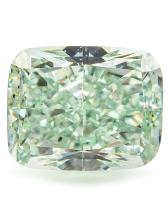
The natural color Diamonds are found as a simple piece of rock and vary in the level of quality. The diamonds found in the nature are the rough uncut diamonds.
The value an uncut diamond, an uncut unpolished diamond and that of a cut and polished diamond in some beautiful shape vary to a high degree.
The cost of uncut diamonds tend to be lower than that of a cut diamond as one would imagine. The article goes on to describe what exactly is a cut diamond and the various shapes as wells the varying quality and price.
Diamond Shapes:
Natural color Diamonds can be cut into different shapes and each shape takes a varying level of skill. In fact some of the shapes are so hard to achieve that it takes the touch of a highly experienced diamond cutter and some state of the art tools make. Here are some of the more popular shapes:
Round:
This is one shape that is very popular and also one of the most technically advanced of all the shapes. The round brilliant shape requires the use of more advanced cutting technology.
Princess:
The next most popular shape is the Princess shape and is typically square shape and sometimes rectangle too. This shape was created in 1980s and also displays high quality of brilliance. It is very popular and often seen as the alternative to the popular round shape. The Princess Diamond is often found in engagement rings.
Emerald:
The Emerald cut is also a very popular cut although it is not a brilliant cut. It is a large open table with a step cut. It is close to the rectangular shape and resembles the natural diamond shape in many ways. It is a very elegant cut and considered vintage by some. This too is preferred by many due to the fact that it is no as vibrant as the others.
Asscher:
The Asscher diamond is very similar to the emerald cut. The subtle difference being that the Asscher cut has larger step facets along with dramatically cut corners and square shape. At the same time this slightly modified cut results in more light reflection and fire than the emerald shaped diamond. An Asscher diamond with a H color grade or higher is usually recommended.
Oval:
The oval diamond resembles the round shaped diamond is some ways. It has a very high level of brilliance but at the same time if the stone is not cut to perfection there are changes that it will cause a bottle effect, or several other anomalies might occur.
Marquise:
The marquise has a football like shape which maximizes the illusion of increased diamond weight, giving the appearance of a much larger looking diamond. It has high level of brilliance and light reflection.
Radiant:
The radiant shape is considered to be the so called father of fancy cut diamonds since it was first introduced over 20 years ago. It is also the first to have a brilliant facet pattern. It is considered to be the idea shape for colored diamonds due to its characteristics.
Heart:
The heart shape diamond can vary in height and width to a great extent. It is understandingly associated with love and is often the first choice for an anniversary ring and a Mother’s day necklace.
Pear:
This too is a brilliant shape and is a combination of the round and the marquis shapes. There are many popular diamonds around that are in this shape and it too is preferred by many.
Cushion:
The cushion shaped diamond is one diamond where the name does not have anything to do with the shape. It is also called, rather technically called the Old Mine Cut and has been around since before the 1900s. This too is a fancy shape diamond with brilliant angles and was more popular before the round shaped diamond came into existence.
Diamond Quality:
- Diamonds are found in the nature and produced as a result several natural process taking place. Thus it is evident that no two diamonds found are the same and all the diamonds found a likely to have some level of impurities (mixture of other elements).
- The ones that have the least level of impurities is what we call a flawless diamond. Hence it is needless to say that the flawless diamonds are extremely rare and hence the quality of the diamond is found using the grading system developed by GIA which is based on the 4Cs, Clarity, Color, Cut and Carat.
Guild Hall Diamonds:
- The diamond buyers do not always now the facts about diamonds. There are a few who tend to do some research prior to making an expensive purchase (like buying the diamond)
- It can hardly compare with the many years of experience that can be provided by Guild Hall Diamonds. In addition to which they also offer assistance and help while grading the diamonds.












